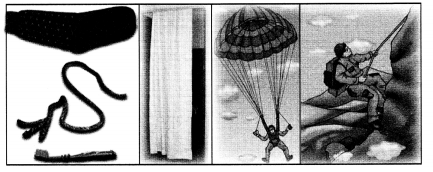CBSE Class 8 Science Notes Chapter 3 Synthetic Fibres and Plastics
Synthetic Fibres and Plastics Class 8 Notes Understanding the Lesson
1. A fabric is the material used for making clothes.
2. Fabrics are made from fibres obtained from natural or artificial source.
3. Beside clothes, fibres are also used for making carpets, sail of boats, parachutes, upholstery and many more items.
4. Fibres can be natural or artificial. Fibres such as cotton, wool, jute and silk are natural fibres whereas rayon, nylon and polyester are artificial fibres.
5. The man-made fibres produced from chemical substances are called synthetic fibres.
6. Synthetic fibres are also known as man-made fibres or artificial fibres.
7. Depending upon the types of chemicals used for manufacturing of the synthetic fibres they are called rayon, nylon, polyester and acrylic.
8. Rayon or artificial silk is made from cellulose obtained from wood pulp.
9. It can be dyed in a wide variety of colours.
10. Nylon was the first synthetic fibre produced by man in 1935.

11. Nylon fibres are strong, elastic, light, lustrous and easy to wash.
12. It is used to make many items like socks, ropes, tents, toothbrushes, car seat belts, curtains, etc.
13. Terylene and dacron are polyester fibres.
14. It is made from two monomers, terephthalic acid and ethylene glycol.
15. It is used for making PET bottles, jars, floppy discs, shirts, hats, etc.
16. Acrylic is the synthetic fibre that resembles wool in its texture and properties.
17. It is used to make sweaters, shawls, socks, etc.
18. They dry up soon, are durable, less expensive, readily available and easy to maintain.
19. A plastic is a synthetic material which can be set into desired shape when soft and then hardened to produce a durable article.
20. Some plastic polymers have linear arrangement of units, whereas in others it is cross-linked arrangement.

21. Thermoplastic is a plastic which gets deformed easily on heating and can be bent easily, e.g., polythene and PVC. These are used for manufacturing toys, combs, containers, etc.
22. Thermosetting plastics is a plastic which when moulded once cannot be softened by heating, e.g., bakelite and melamine.
23. Bakelite is used for making electrical switches, handles of various utensils, etc.
24. Melamine is used for making floor tiles, kitchenware, etc.
25. Plastic is a non-biodegradable substance. So, the articles made of plastics do not rot when they are thrown away after use. This pollute the environment.
26. When the plastic waste materials are burnt, they produce poisonous gases which pollute the air. The 4R principle, Reduce, Reuse, Recycle and Recover should be our basic mantra to minimise the hazards associated with the disposal of plastic wastes.
27. We must think twice before using plastic items.
Class 8 Science Chapter 3 Notes Important Terms
Acrylic: The synthetic fibre that resembles wool in its texture and properties is called acrylic.
Artificial silk: A man-made fibre obtained from chemical treatment of wood pulp which has properties similar to that of silk is called artificial silk.
Nylon: A fully synthetic polymer which is prepared from coal, water and air is called nylon.
Plastic: Those substances which are mostly synthetic in nature, obtained mainly from petrochemical sources and can be moulded into different shapes are called plastics.
Polyester: The synthetic fibre which is used for making PET bottles, home furnishings, etc., and are blended with natural fibres to enhance its properties is called polyester.
Polymer: The compound that are made up of small repeating units, joined together through bonds in a linear pattern is called polymer.
Polythene: The compound obtained from ethylene under high temperature, high pressure and in the presence of a catalyst is called polythene.
Rayon: A man-made fibre which is produced by the chemical processing of wood pulp, which is a natural substance is called rayon.
Synthetic fibres: The fibres which are made by human beings with the help of chemical substances are called synthetic fibres.
Terylene: A common variety of polyester which can be drawn into very fine fibres is called terylene.
Thermoplastics: Those plastics which soften on heating and hardened on cooling are called thermoplastics.
Thermosetting plastics: Those plastics, which when moulded once, cannot be softened again and lose their plasticity are called thermosetting plastics.